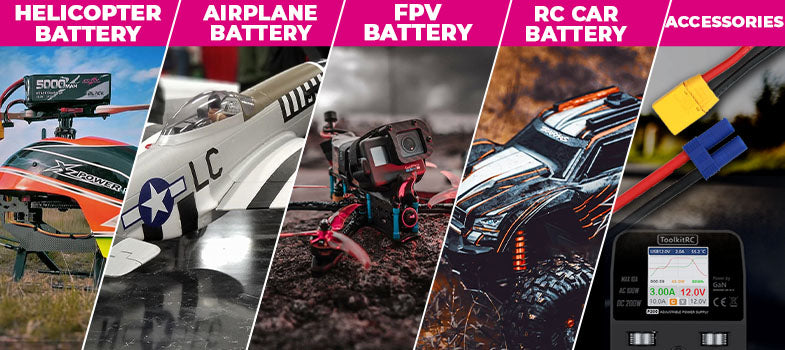
Baterías CNHL Lipo
CNHL tiene como objetivo proporcionar baterías Li-Po de alta calidad y productos RC a todos los entusiastas del hobby con un excelente servicio al cliente y precios competitivos
Si alguna vez te has preguntado cómo mantener tus packs LiHV saludables a largo plazo, esta guía cubre carga, voltaje de almacenamiento y las diferencias clave vs. LiPo—con números claros y prácticos.

Siempre conecta primero el cable de carga al cargador, luego conecta la batería. Evita desconectar el cable de carga mientras el pack sigue conectado.
Cuando no vayas a volar/conducir pronto, ajusta el pack a ~3.80V por celda (también llamado voltaje de almacenamiento) usando la función de almacenamiento del cargador. Deja que la batería se enfríe antes de almacenarla y guárdala en un lugar seco y seguro contra incendios.
El voltaje cae bajo carga y se recupera en reposo. Para proteger la salud del pack:
P1. ¿Puedo cargar un pack LiHV usando el modo normal LiPo?
R: Sí, pero se detendrá en 4.20V/celda y no usarás todo el potencial LiHV. Para máxima capacidad/rendimiento, usa modo LiHV (4.35V/celda).
P2. ¿Cuál es el voltaje ideal de almacenamiento para un LiHV 6S?
R: Aproximadamente 22.8V total (≈3.8V × 6). En general: voltaje total de almacenamiento ≈ 3.8V × número de celdas.
P3. ¿Cuál es un mínimo seguro después de cada vuelo?
R: Mantén alrededor de 3.6–3.7V por celda (en reposo). Evita <3.5V por celda en uso normal y evita operación prolongada cerca de ~3.3V.
P4. ¿Necesito cargar completamente un LiHV nuevo antes de almacenarlo?
R: No. Puedes configurarlo directamente a voltaje de almacenamiento (~3.8V/celda) y dejarlo ahí.
P5. ¿Cuánto tiempo puede un LiHV mantenerse con carga completa?
R: Mantén las ventanas de carga completa cortas (idealmente <24 horas). Para intervalos más largos, vuelve al voltaje de almacenamiento.
P6. ¿Qué configuraciones del cargador debo revisar?
R: Confirma el modo de química LiHV, corriente moderada (≤1C), cable de balance conectado y temperatura controlada.
¿Buscas packs de alto voltaje comprobados? Explora nuestra selección dedicada aquí: Colección de Baterías CNHL High Voltage (LiHV).

CNHL tiene como objetivo proporcionar baterías Li-Po de alta calidad y productos RC a todos los entusiastas del hobby con un excelente servicio al cliente y precios competitivos
Especificaciones: Número de Stock: 500706EC5 Capacidad: 5000mAh Voltaje: 22.2V / 6-Celdas / 6S1P Tasa de Descarga: 70C Continua / 140C Ráfaga Tas...
Ver detalles completosEspecificaciones: Número de stock: 1351506PZ Capacidad: 1350mAh Voltaje: 22.2V / 6 celdas / 6S1P Tasa de descarga: 150C continua / 300C ráfaga Ta...
Ver detalles completosEspecificaciones Número de Stock: 1301306BK Capacidad: 1300mAh Voltaje: 22.2V / 6-Celdas / 6S1P Tasa de Descarga: 130C Continua / 260C Pico Tasa d...
Ver detalles completosEspecificaciones: Número de stock: 1501204 Capacidad: 1500mAh Voltaje: 14.8V / 4 celdas / 4S1P Tasa de descarga: 120C continua / 240C ráfaga Tasa ...
Ver detalles completosEspecificaciones: Número de stock: 220303BK Capacidad: 2200mAh Voltaje: 11.1V / 3 celdas / 3S1P Tasa de descarga: 30C continua / 60C ráfaga Tasa d...
Ver detalles completosAvión corredor deportivo CNHL Havok 1000mm 4S – Construido sobre un probado fuselaje Havok de 1m El CNHL Havok 1000mm 4S Sport Racer RC Plane PN...
Ver detalles completosEl MNRC MN300 es un rastreador de rocas RC 4WD listo para usar (RTR) a escala 1/12, hecho para rastreo ligero, conducción en senderos y diversión...
Ver detalles completosInspirado en el legendario caza británico de la Segunda Guerra Mundial, el Avión RC VOLANTEX Spitfire combina la apariencia clásica de un avión...
Ver detalles completosEl VOLANTEX BF109 Avión RC de 4 Canales RTF trae uno de los cazas más icónicos de la Segunda Guerra Mundial en un paquete compacto y amigable pa...
Ver detalles completosEl avión RC Volantex P51D V2 RTF es un warbird compacto de estilo WWII construido para hacer que aprender a volar sea lo más relajado posible. Co...
Ver detalles completos
Comentarios
Deja un comentario